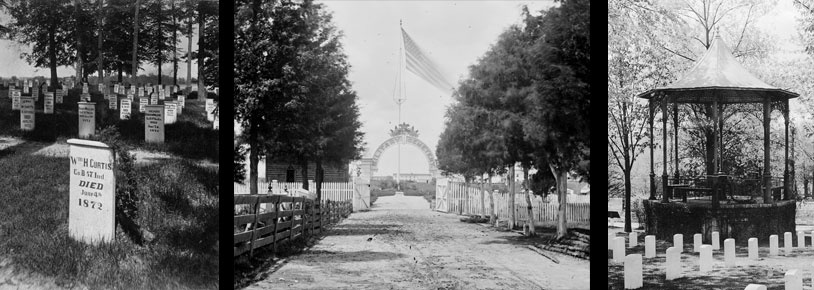

Civil War Era National Cemeteries: Honoring Those Who Served
Raleigh National Cemetery
Raleigh, North Carolina
 |
| Superintendent's Lodge Courtesy of the Department of Veterans Affairs, National Cemetery Administration, History Program |
In May 1861, the legislature of North Carolina passed a resolution to secede, becoming the last state to leave the Union. During the war, Raleigh served as a supply depot and hospital site. A factory in the city produced clothing for Confederate troops.
Raleigh emerged from the Civil War unscathed due to efforts of two former North Carolina governors, David Swain and William Graham. In January 1865, Union General William Tecumseh Sherman began marching his troops north from Savannah. Sherman’s goal was to join Ulysses S. Grant’s forces in Virginia, destroying anything of Confederate military value along the way. In February, Sherman captured the South Carolina capital of Columbia, destroying much of the city. Fearing the same fate for their state capital, Swain and Graham, in concert with Governor Zebulon Vance, traveled to Sherman to ask that he spare Raleigh. Sherman agreed, on condition that his troops meet no resistance. On the morning of April 13, 1865, Sherman and his troops entered the nearly deserted city, immediately setting up a headquarters in the governor’s mansion.
The national cemetery was established while Sherman was in possession of the city on ground previously used as Camp Green, a U.S. Army post for the Union occupation forces. A post cemetery, containing 32 burials, pre-dates the establishment of the national cemetery. The state of North Carolina originally owned the land comprising the cemetery, and the state donated the approximately seven acre plot to the U.S. government in 1871.
The cemetery, located east of the city’s downtown, is rectangular in form, largely flat and shaded by many mature deciduous trees. A brick wall, built in 1875, encloses the cemetery. In 1936, larger wrought-iron gates were installed at the cemetery’s entrance off Rock Quarry Road in order to accommodate vehicular traffic.
 |
Raleigh National Cemetery Courtesy of the Department of Veterans Affairs, National Cemetery Administration, History Program |
A rostrum is located in the southern end of the center burial section of the cemetery. Constructed in 1931, the raised base is octagonal in shape and made from poured concrete, an iron railing encircles the platform and extends down the stairs. It replaced an earlier brick rostrum with the same octagonal shape.
At the approximate center of the cemetery is an artillery monument, an original cast-iron seacoast gun set upright on a large stone base. Affixed to the gun is a shield-like plaque inscribed with the cemetery name, year of establishment, and number of known and unknown interments. The shield plaques were placed in all existing cemeteries circa 1873, and many can still be found in national cemeteries affixed to cannons or lodge walls.
The cemetery contains six group burials dating to World War II, which contain the remains of 16 servicemen. The graves are marked with flat markers that bear the name, rank, and date of death of each of the 16 men. Square stone corners markers at set flush with the ground and define the large graves.
Raleigh National Cemetery is the final resting place for a recipient of the Medal of Honor, the nation's highest military decoration, given for "conspicuous gallantry and intrepidity at the risk of his life above and beyond the call of duty."
| Plan your visit |
Raleigh National Cemetery is located at 501 Rock Quarry Rd. in Raleigh, NC. The cemetery is open for visitation daily from sunrise to sunset; however, no cemetery staff is present on site. The administrative office is located at the New Bern National Cemetery and is open Monday to Friday from 7:30am to 4:00pm; it is closed on all Federal holidays except for Memorial Day and Veterans Day. For more information, please contact the cemetery office at 252-637-2912, or see the Department of Veterans Affairs website. While visiting, be mindful that our national cemeteries are hallowed ground. Be respectful to all of our nation’s fallen soldiers and their families. Additional cemetery policies may be posted on site. Raleigh National Cemetery was photographed to the standards established by the National Park Service’s Historic American Landscapes Survey. |